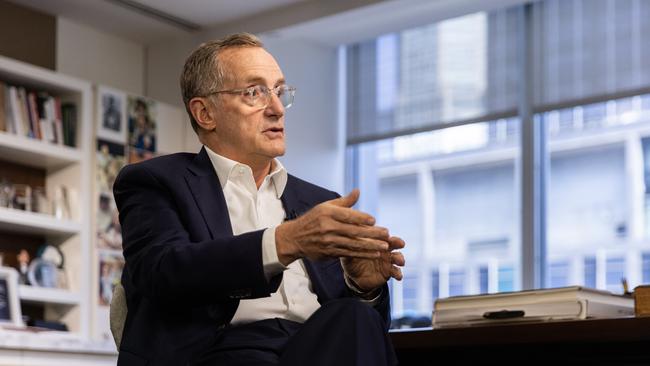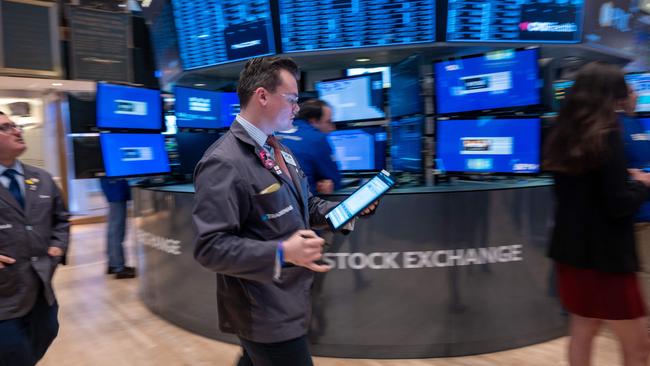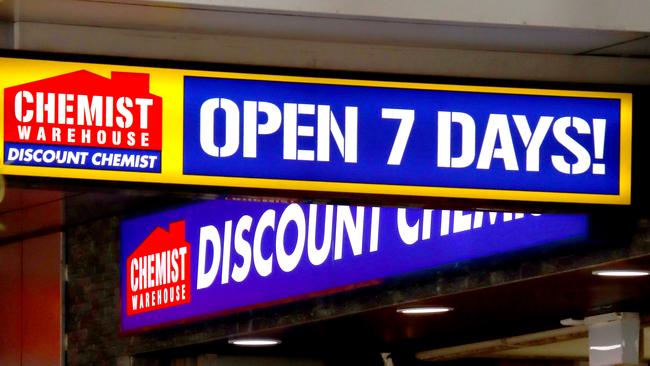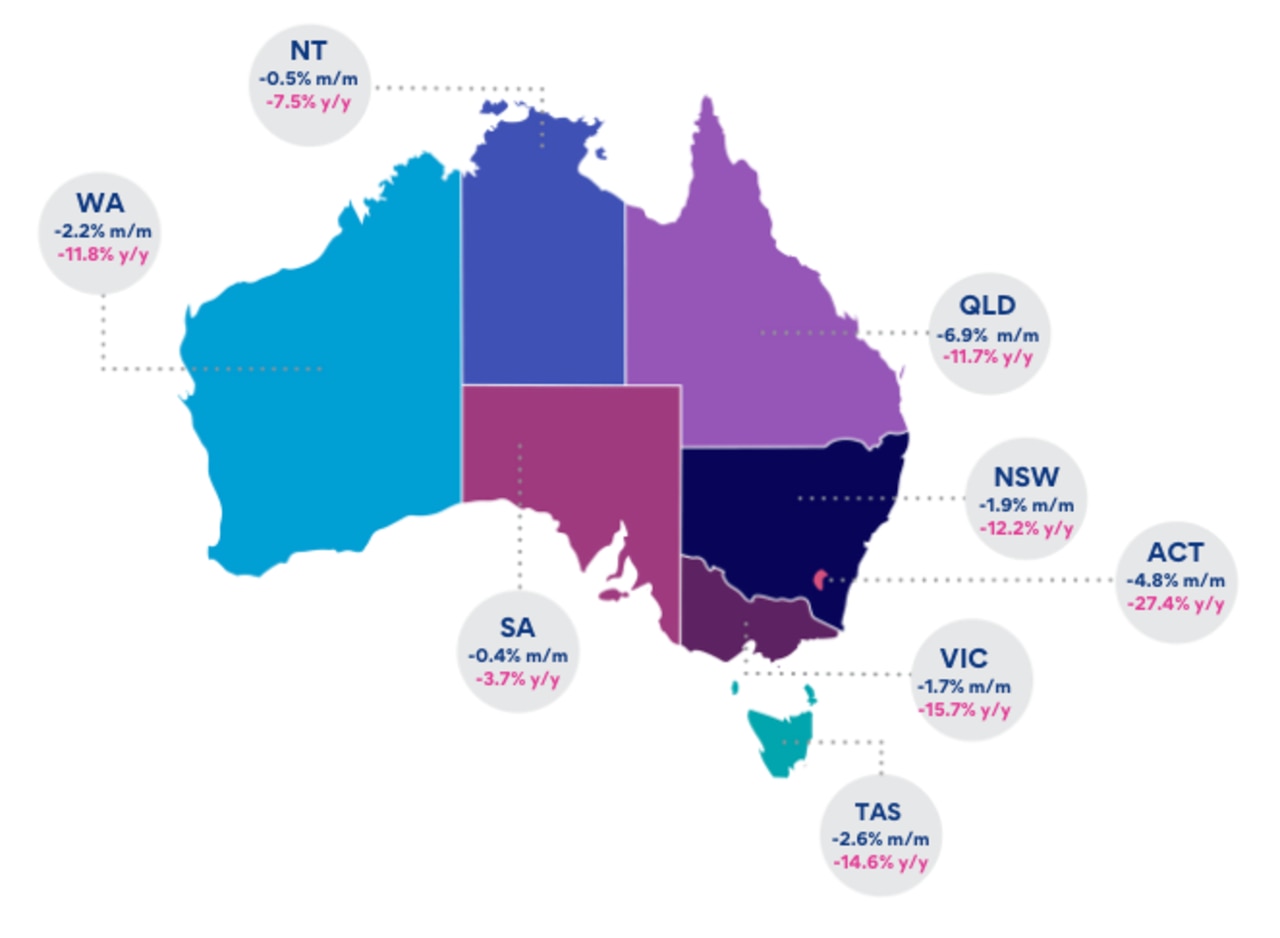Oaktree Captial’s Howard Marks investor memo: The risk of not taking risk
Just as markets have started to get bumpy, investors should take heed of the saying no pain, no gain.

Business
Don't miss out on the headlines from Business. Followed categories will be added to My News.
Just as markets have started to get bumpy on rising Middle East stresses and the shifting outlook for interest rates, billionaire investor Howard Marks has issued an important reminder. Going backward is part and parcel of moving forward. Or more bluntly: no pain no gain.
Marks, the co-founder and co-chairman of hedge fund Oaktree Capital with nearly $300bn under management - remember local fund giant Australian Super has a little over $315bn under management.
For decades, Marks has consistently spoken to his clients about the path to achieving investment outperformance. This has often involved changing positions, such as recently coming around to a view that bitcoin can be likened to gold or art - assets with no intrinsic value but hold significant value.
In his latest memo sent to investors, Marks says he was inspired by an article that appeared this month under the sports section in the Wall Street Journal: Chess Teaches the Power of Sacrifice.

As the title suggests, the piece written by chess grandmaster Maurice Ashley underscores the role that sacrifice plays in chess where most positions can’t be won or saved without giving another piece away. Intentionally losing a piece – the sacrifice – becomes part of the game plan, Marks says.
This can be in the form of “sham” sacrifices, where the trade-off is something tangible of value in return. Then there’s “real” sacrifices that involve a bigger leap of faith given gains are neither immediate nor tangible - however they may result in gaining ground or launching a bigger attack.
The analogy to investing becomes obvious pretty quickly, Marks says.
Buying a 10-year US bond might be “sham” sacrifice because while you give up your money for a decade, the same decision comes with the certainty of income. However, most other investments involve “real” sacrifice because often the risk of loss borne in pursuit of gains that are neither immediate nor tangible. Whatever the path of risk, not being willing to take risks is an extremely risky strategy. Marks puts this another way - the indispensability of risk. Or there’s the better known phrase: No pain, no gain.
Marks breaks this up into three choices for investors: The first is to avoid risk and have little or no return. Secondly, they can opt for modest risk and settle for modest return.
But the third path, earning high returns, requires that you bear meaningful risk - either in the possibility of loss in the chase for gains, or in professional investor terms underperformance in the pursuit of outperformance.

Most investors are capable of accomplishing the first and most of the second, Marks says.
But the challenge in investing lies in the pursuit of some version of the third point.
“Earning high returns – in absolute terms or relative to other investors in a market – requires that you bear meaningful risk”.
This is either “the possibility of loss in the pursuit of absolute gain or the possibility of underperformance in the pursuit of outperformance,” Marks says.
“There’s such a thing as the risk of taking too little risk. Most people understand this intellectually, but human nature makes it hard for many to accept the idea that the willingness to live with some losses is an essential ingredient in investment success,” he adds.
Applying this strategy, Marks says, investors must accept that success is likely to stem from making many investments, and they have to also accept there will be a portion of these investments that won’t succeed.
“You have to put it all out there. You have to take a shot. Not every effort will be rewarded with high returns, but hopefully enough will do so to produce success over the long term”.
The bottom line on the quest for superior investment returns is clear, Marks says. “You shouldn’t expect to make money without bearing risk, but you shouldn’t expect to make money just for taking risk. You have to sacrifice certainty, but it has to be done skilfully and intelligently, and with emotion under control,” Marks concludes.
Test for Chemist Warehouse
Chemist Warehouse may have passed an important hurdle on the path to its $9bn tie-up with smaller rival Sigma Healthcare.
As the competition regulator weighs up whether it should allow the biggest chemist retailer to merge with Sigma, Australia’s biggest drugs distributor and owner of the Amcal and Guardian brands, one of the strongest critics of the deal may be softening its view.
Last December, Chemist Warehouse stepped into the spotlight with the founders Jack Gance and Mario Verrocchi – agreeing to a reverse listing through Sigma, in a deal that gives outside investors exposure to the powerful retailing machine.
It’s a deal that truly sees the tail wagging the dog, with Chemist Warehouse to end up with 86 per cent of the merged entity following the deal and Sigma representing the rest.
Disclosures by Chemist Warehouse have given investors the first real insight into the size and scale of the retailer that until now has largely been seen as a black box. This includes annualised Australian and international revenue global revenue of more than $9bn and annualised pre-tax profit running at $640m. From a single shop in Melbourne’s northern suburbs, Chemist Warehouse has serious scale in retail and distribution across Australia, as well as an online foothold in China and plans to expand into Europe.

The window for the ACCC to accept public submissions on the merger has now closed. Significantly, the competition regulator had been bracing for a wave of protests about the merger from chemists, organised by the powerful Pharmacy Guild of Australia, which has previously expressed concerns about the merger.
Indeed, as part of the informal merger review, the ACCC established a separate online portal to help triage opposition from chemists. But this didn’t come – only a handful of protests are understood to have trickled through.
When details about the deal were first unveiled in December, the Guild said it posed significant questions and risks to patient care and competition in the sector. While the guild is believed to have made its own submission, its biggest strength is using the collective power of nearly 6000 community pharmacies across the country. However, its strength has long been through politics than merger process.
A spokesperson for the ACCC declined to comment on the number of submissions received or the review process.
The competition regulator has pencilled June 13 for the final decision on the deal, although given the complexity of the deal it is more likely this will be pushed back deeper into the second half of this calendar year.
Loggerheads
For years, the Pharmacy Guild and Chemist Warehouse have been at loggerheads as the community pharmacies have tried to slow the expansion of the discounter. Location rules have prevented Chemist Warehouse from securing prime locations, and slowed the expansion, particularly in NSW which has among the toughest rules relating to pharmacy ownership.
The guild too has used its political clout in opposing supermarket major Woolworths, trying to open up the sector by moving into in-store pharmacy retailing. It also threatened to target Woolworths again when it was in the running to buy Priceline owner API. Wesfarmers eventually emerged on top with a $760m offer. Only a mild protest from its membership could signal a shift inside the Pharmacy Guild about its approach to the monster rival.
More recently, the guild launched a politically damaging campaign opposing the 60-day dispensing rules, arguing it will slice revenue. Chemist Warehouse sat out of the protests and, over the time, the rules seem to advantage its discounting retail model. Countering this, Chemist Warehouse has argued it has added to competition in the pharmacy industry, particularly through lower prices for consumers.

Recent comments too by the bosses of Woolworths and Coles at the Senate inquiry into supermarkets, they see Chemist Warehouse a direct competitor in the market for personal care and vitamins. Accounts released by Sigma in March show Chemist Warehouse’s near 560 Australian stores generate an annualised $7.8bn in sales.
Barrenjoey's retail analyst Tom Kierath expects regulatory approval will eventually arrive, given the highly fragmented nature of the industry. However, there is a risk of the deal being opposed and this would be more damaging to Sigma given the potential loss of some Amcal or Guardian franchisees.
Kierath says if the deal moves ahead, the combination of Chemist Warehouse and Sigma will see the creation of a high-growth retailer, much like Bunnings Warehouse or JB Hi-Fi in its early expansion days.
johnstone@theaustralian.com.au
More Coverage
Originally published as Oaktree Captial’s Howard Marks investor memo: The risk of not taking risk





